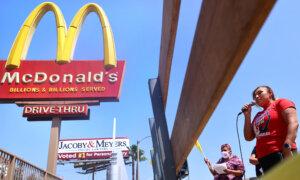In response to backlash over a report on Wendy’s aiming to begin changing its pricing structure in 2025, the fast food restaurant has denied that it would engage in surge pricing.
“Wendy’s will not implement surge pricing, which is the practice of raising prices when demand is highest,” a spokesperson told The Epoch Times. “We didn’t use that phrase, nor do we plan to implement that practice.”
In mid-February, the company issued its fourth-quarter and full-year earnings for 2023, which included an update on changes to its digital model.
“One initiative is digital menu boards, which are being added to the U.S. company-operated restaurants,” the spokesperson said. “We said these menu boards would give us more flexibility to change the display of featured items.”
However, the spokesperson said, some media outlets “misconstrued” the change as “an intent to raise prices when demand is highest at our restaurants.”
“We have no plans to do that and would not raise prices when our customers are visiting us most,” the spokesperson said. “Any features we may test in the future would be designed to benefit our customers and restaurant crew members.”
Instead, digital menu boards help staff make changes to the menu “at different times of day” with the ability to offer discounts during “slower times of day.”
“Wendy’s has always been about providing high-quality food at a great value, and customers can continue to expect that from our brand,” the spokesperson said.
Dynamic Pricing
Earlier this month, Kirk Tanner, the new CEO and president of The Wendy’s Co., told market analysts in February, according to Nation’s Restaurant News, when discussing future plans for the Dublin, Ohio-based burger company.Mr. Tanner said it’s investing $20 million in a digital menu board for all restaurants to have in operation by the end of 2025, with an additional $10 million to support enhancements.
The digital menu board, he said, is designed to improve staff experience, increase sales, and help with order accuracy, in addition to utilizing dynamic pricing and daypart offerings, “Wendy’s Fresh AI”-enabled menu changes, and suggestive selling.
A spokesperson for Wendy’s told Food & Wine that suggesting selling and menu changes will depend on such factors as the weather.
“Dynamic pricing can allow Wendy’s to be competitive and flexible with pricing, motivate customers to visit, and provide them with the food they love at a great value. We will test a number of features that we think will provide an enhanced customer and crew experience,” the spokesperson said.
According to Investopedia, dynamic pricing is a strategy by which “companies set flexible prices for their products or services that change, according to current market demand.”
“Businesses are able to change prices based on algorithms that take into account competitor pricing, supply, and demand, and other external factors in the market,” Investopedia said. “Dynamic pricing is a common practice in several industries such as hospitality, travel, entertainment, retail, electricity, and public transport.”
The confusion comes in with whether there is a difference between “dynamic pricing” and “surge pricing,” the latter phrase Wendy’s denies using.
‘Price Gouging’
Sen. Elizabeth Warren (D-Massachusetts) criticized the company, calling surge pricing “pricing gouging.”“@Wendys is planning to try out ‘surge pricing’—that means you could pay more for your lunch, even if the cost to Wendy’s stays exactly the same,” the senator posted on X. “It’s price gouging plain and simple, and American families have had enough.”
Jim Sargent, a local resident of Wendy’s test city of Portsmouth, told WMUR Manchester (New Hampshire) that he would still go to the fast food outlet if they had started surge pricing, but that he thinks it’s an odd model.
“I don’t think it’s an idea that’s probably going to succeed,” he said.
Donald Kreis with the New Hampshire Office of the Consumer Advocate explained the logic behind surge pricing to WMUR Manchester.
“When everybody wants to eat hamburgers at exactly the same time, it leads to very inefficient use of the available resources, so if you raise the price in times of high demand, then that encourages people to maybe eat a hamburger at a slightly different time, maybe a little earlier, maybe a little later,” he said, adding that this would help staff better manage demand.







